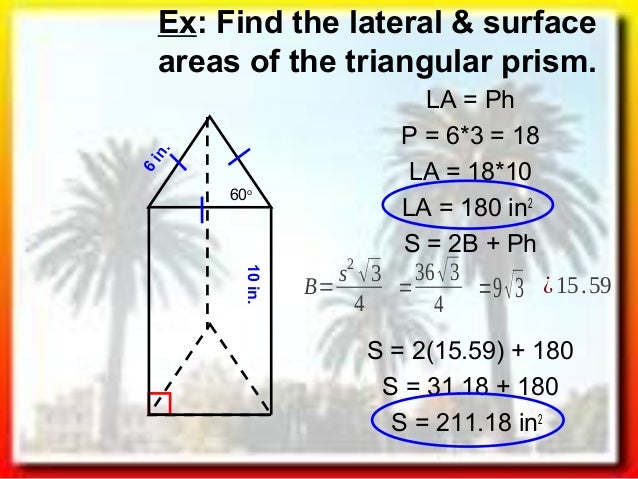

Total Surface area of Rectangular Prism = 2B + Ph = 2 ( lb + bh + hl) Lateral surface area of the Rectangular Prism = Ph = 2h ( l + b) Total surface area of a rectangular prism = (base width x height) + (height x base length) + 2 x (base length x base width) The volume of a triangular prism = Area of base triangular prism × heightĪ & c = sides of the triangular base Rectangular Prism FormulasĪ Prism having two rectangular bases are parallel to each other and its ends are joining with four rectangular faces then it is called as a rectangular prism. Total Surface area of triangular prism = 2B + Pl = (2 x Triangle area) + Total surface area of a triangular prism formula = ( 2 × Triangular Base Area) + (Triangular Base Perimeter × Length) = (Apothem length x base length) + 3 (base length x height) Lateral surface area of the triangular prism = Perimeter of triangle x l = (a + b + c) l Here we are discussing about prism formulas for right prim Triangular Prism formulasĪ Prism having two parallel triangular surfaces, one rectangular base and two rectangular surfaces are inclined to each other then is is called triangular prism. i.e A prism is said to be polygonal if its two ends are polygons Prism can be classified into different types according to their base shape.Ī prism is said to be triangular if its two ends are triangles it is called rectangular if its ends are rectangles and so on. Volume of right prism = Area of the base ( B) x height ( h) Total surface area of the right prism = Lateral surface area of the right prism + The area of the two plane ends Lateral surface area of the right prism = Perimeter of base (P) x height (h) If the side-edges of a prism are not perpendicular to its ends then it is called as an Oblique prism. The side-edges of a right prism are perpendicular to its base or ends. The flat polished surfaces are refract light. According to this view a prism is defined as the transparent optical element with polished into geometrical and optically significant shapes of lateral faces join the two polygonal bases. The lateral faces are mostly rectangular.

Its dimensions are defined by dimensions of the polygon at its ends and its height. The prism two faces is called the ends and other faces are called the lateral faces or side faces.

Prism can be also defined as a polyhedron with two polygonal bases parallel to each other 1 Formulas of a Prism – Surface Area and Volumeįormulas of a Prism – Surface Area and Volume What is PrismĪ prism mathematically defined as, It is a solid three dimensional object which can have any polygon at both its ends.The figure below shows the two kinds of triangular prisms.



 0 kommentar(er)
0 kommentar(er)
